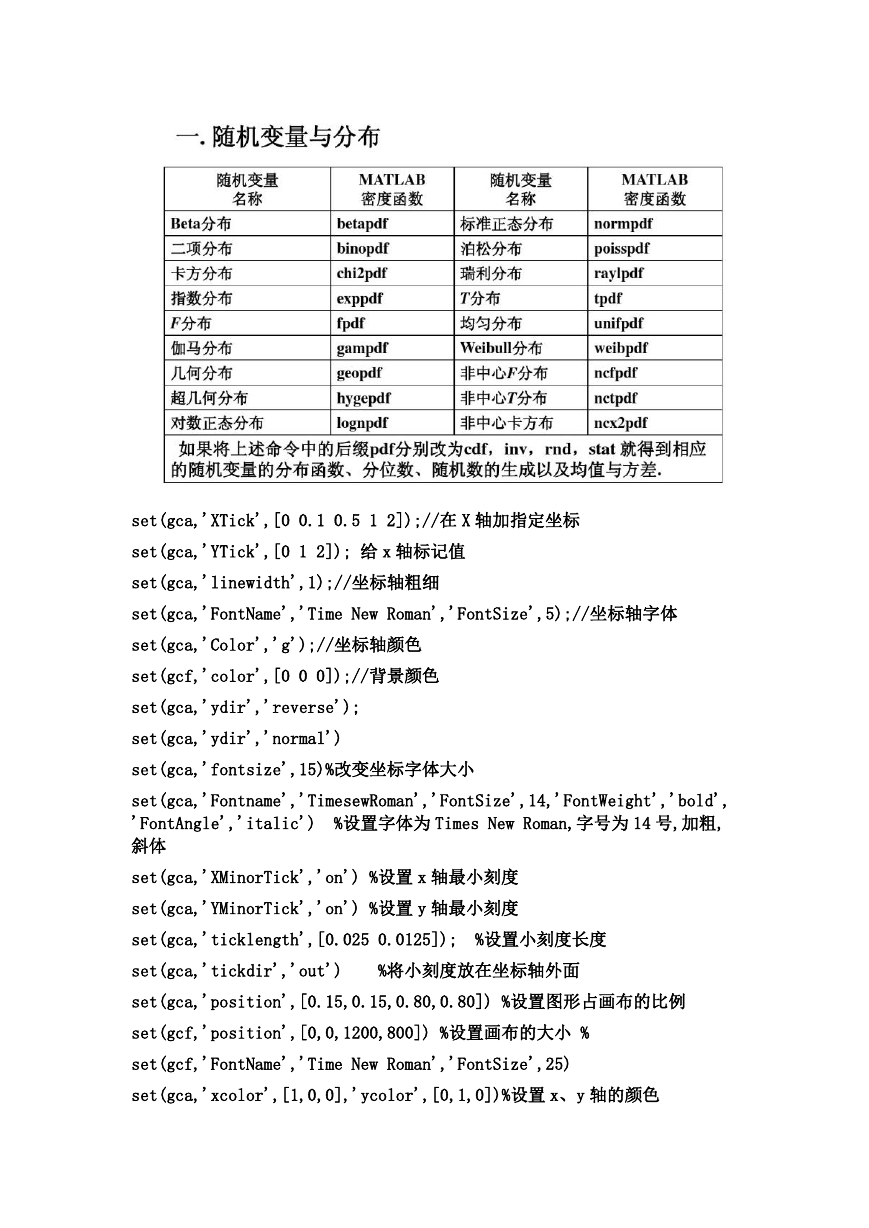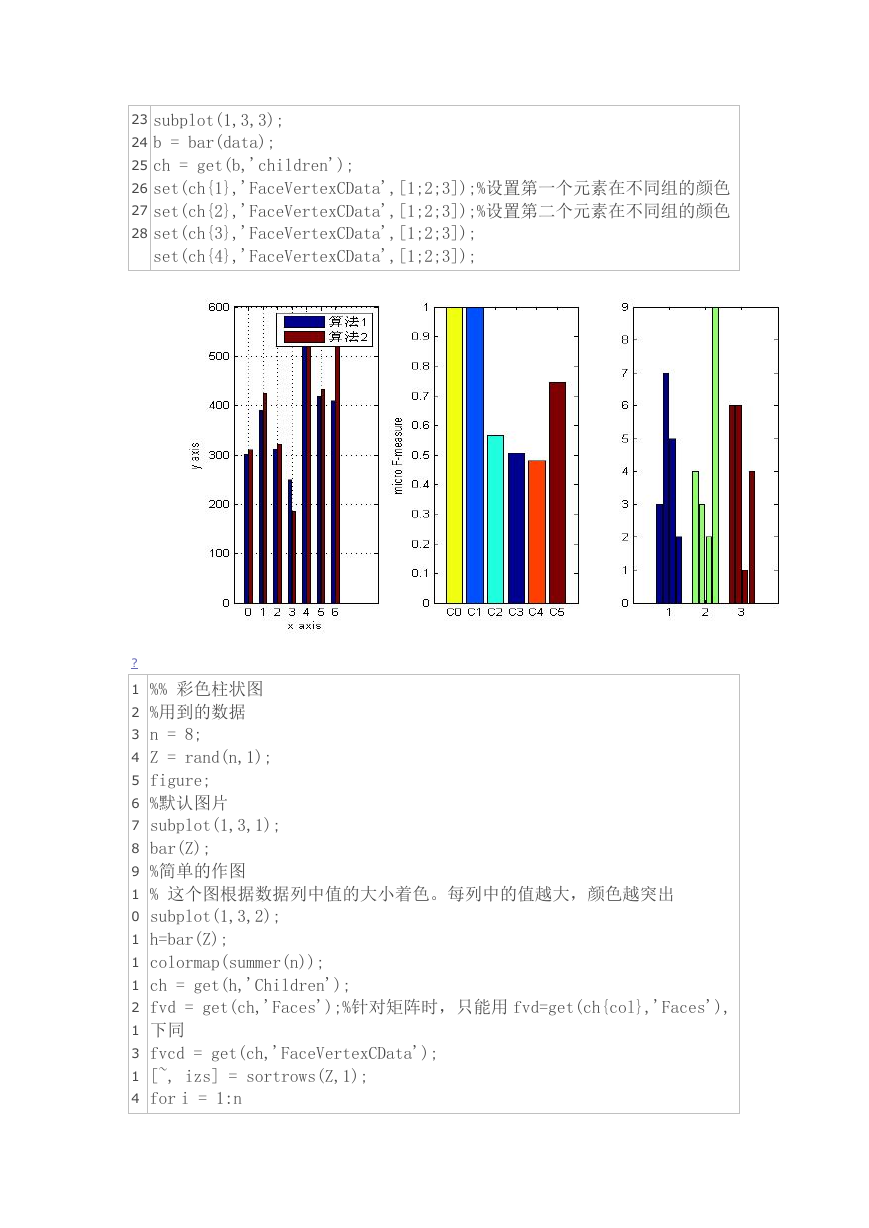set(gca,'XTick',[0 0.1 0.5 1 2]);//在 X 轴加指定坐标
set(gca,'YTick',[0 1 2]); 给 x 轴标记值
set(gca,'linewidth',1);//坐标轴粗细
set(gca,'FontName','Time New Roman','FontSize',5);//坐标轴字体
set(gca,'Color','g');//坐标轴颜色
set(gcf,'color',[0 0 0]);//背景颜色
set(gca,'ydir','reverse');
set(gca,'ydir','normal')
set(gca,'fontsize',15)%改变坐标字体大小
set(gca,'Fontname','TimesewRoman','FontSize',14,'FontWeight','bold',
'FontAngle','italic')
%设置字体为 Times New Roman,字号为 14 号,加粗,
斜体
set(gca,'XMinorTick','on') %设置 x 轴最小刻度
set(gca,'YMinorTick','on') %设置 y 轴最小刻度
set(gca,'ticklength',[0.025 0.0125]);
%设置小刻度长度
set(gca,'tickdir','out')
%将小刻度放在坐标轴外面
set(gca,'position',[0.15,0.15,0.80,0.80]) %设置图形占画布的比例
set(gcf,'position',[0,0,1200,800]) %设置画布的大小 %
set(gcf,'FontName','Time New Roman','FontSize',25)
set(gca,'xcolor',[1,0,0],'ycolor',[0,1,0])%设置 x、y 轴的颜色
�
set(gca,'FontSize',50)%设置坐标字体的大小
图形是呈现数据的一种直观方式,在用 Matlab 进行数据处理和计算后,我们一
般都会以图形的形式将结果呈现出来。尤其在论文的撰写中,优雅的图形无疑会
为文章加分。本篇文章非完全原创,我的工作就是把见到的 Matlab 绘图代码收
集起来重新跑一遍,修改局部错误,然后将所有的图贴上来供大家参考。大家可
以先看图,有看中的可以直接把代码 Copy 过去改成自己想要的。
?
1
2
3
4
5
6
7
8
9
10
11
12
13
14
15
16
17
18
19
20
21
22
23
%% 直方图图的绘制
%直方图有两种图型:垂直直方图和水平直方图。而每种图型又有两种表现模
式:累计式:分组式。
figure;
z=[3,5,2,4,1;3,4,5,2,1;5,4,3,2,5]; % 各因素的相对贡献份额
colormap(cool);% 控制图的用色
subplot(2,3,1);
bar(z);%二维分组式直方图,默认的为'group'
title('2D default');
subplot(2,3,2);
bar3(z);%三维的分组式直方图
title('3D default');
subplot(2,3,3);
barh(z,1);%分组式水平直方图,宽度设置为 1
title('vert width=1');
subplot(2,3,4);
bar(z,'stack');%累计式直方图,例如:1,1+2,1+2+3 构成了第一个 bar
title('stack')
subplot(2,3,5);
bar3h(z,0.5,'stacked');%三维累计式水平直方图
title('vert width=1 stack');
subplot(2,3,6);
bar3(z,0.8,'grouped');%对相关数据的颜色进行分组,默认的位'group'
title('width=0.8 grouped');
�
?
1
2
3
4
5
6
7
8
9
10
11
12
13
14
15
16
17
18
19
20
21
22
%% =========柱状图的进阶==========
figure;
y=[300 311;390 425; 312 321; 250 185; 550 535; 420 432; 410 520;];
subplot(1,3,1);
b=bar(y);
grid on;
set(gca,'XTickLabel',{'0','1','2','3','4','5','6'})
legend('算法 1','算法 2');
xlabel('x axis');
ylabel('y axis');
%使仅有的一组柱状图呈现不同颜色,默认的位相同颜色
data = [1.0, 1.0, 0.565, 0.508, 0.481, 0.745];
subplot(1,3,2);
b = bar(data);
ch = get(b,'children');
set(ch,'FaceVertexCData',[4;2;3;1;5;6]);%使用 Indexed 形式指定每组
bar 的颜色
set(gca,'XTickLabel',{'C0','C1','C2','C3','C4','C5'})
axis([0 7 0.0 1.0]);
ylabel('micro F-measure');
%使每个 bar 颜色不同,默认的是每个元素在不同组的颜色相同
data = [3, 7, 5, 2;4, 3, 2, 9;6, 6, 1, 4];
�
23
24
25
26
27
28
subplot(1,3,3);
b = bar(data);
ch = get(b,'children');
set(ch{1},'FaceVertexCData',[1;2;3]);%设置第一个元素在不同组的颜色
set(ch{2},'FaceVertexCData',[1;2;3]);%设置第二个元素在不同组的颜色
set(ch{3},'FaceVertexCData',[1;2;3]);
set(ch{4},'FaceVertexCData',[1;2;3]);
?
1
2
3
4
5
6
7
8
9
1
0
1
1
1
2
1
3
1
4
%% 彩色柱状图
%用到的数据
n = 8;
Z = rand(n,1);
figure;
%默认图片
subplot(1,3,1);
bar(Z);
%简单的作图
% 这个图根据数据列中值的大小着色。每列中的值越大,颜色越突出
subplot(1,3,2);
h=bar(Z);
colormap(summer(n));
ch = get(h,'Children');
fvd = get(ch,'Faces');%针对矩阵时,只能用 fvd=get(ch{col},'Faces'),
下同
fvcd = get(ch,'FaceVertexCData');
[~, izs] = sortrows(Z,1);
for i = 1:n
�
row = izs(i);
fvcd(fvd(row,:)) = i;
end
set(ch,'FaceVertexCData',fvcd)
%图片会以渐变的方式着色,效果非常不错
subplot(1,3,3);
h=bar(Z);
ch = get(h,'Children');
fvd = get(ch,'Faces');
fvcd = get(ch,'FaceVertexCData');
[zs, izs] = sortrows(Z,1);
k = 128; % 准备生成 128 *3 行的 colormap
colormap(summer(k)); % 这样会产生一个 128 * 3 的矩阵,分别代表[R G B]
的值
% 检视数据
whos ch fvd fvcd zs izs
%
Bytes
Class
Size
Name
Attributes
ch
1x1
66x1
%
%
ble
%
%
%
%
%
shading interp % Needed to graduate colors
for i = 1:n
fvcd
fvd
izs
zs
13x4
13x1
13x1
8 dou
528 double
416 double
104 double
104 double
color = floor(k*i/n); % 这里用取整函数获得 color 在 colormap
中行
row = izs(i); % Look up actual row # in data
fvcd(fvd(row,1)) = 1; % Color base vertices 1st index
fvcd(fvd(row,4)) = 1;
fvcd(fvd(row,2)) = color; % Assign top vertices color
fvcd(fvd(row,3)) = color;
end
set(ch,'FaceVertexCData', fvcd); % Apply the vertex coloring
set(ch,'EdgeColor','k');
1
5
1
6
1
7
1
8
1
9
2
0
2
1
2
2
2
3
2
4
2
5
2
6
2
7
2
8
2
9
3
0
3
1
3
2
3
3
3
4
3
5
3
6
�
3
7
3
8
3
9
4
0
4
1
4
2
4
3
4
4
4
5
4
6
4
7
4
8
4
9
5
0
5
1
5
2
�
?
1
2
3
4
5
6
7
8
9
10
11
12
13
14
15
16
17
18
19
20
%% 绘制统计直方图
%hist(y):如果 y 是向量,则把其中元素放入 10 个条目中,且返回每条中的
元素的个数;如果 y 为矩阵,则分别对每列进行处理,显示多组条形。
%[n,xout]=hist(y,x):非递减向量 x 的指定 bin 的中心。向量 xout 包含频
率计数与条目的位置。
x=-10:.1:10;
y1=randn(2008,1);
y2=randn(2008,3);
figure;
colormap(winter);
subplot(2,2,1);
hist(y1);%把其中元素放入 10 个条目中
title('y1 为向量,default,n=10');
subplot(2,2,2);
hist(y2);%分别对每列进行处理,显示多组条形
title('y2 为矩阵');
subplot(2,2,3);
hist(y1,x);%用户也可以使用[n,xout]=hist(y1,x);bar(xout,n)绘制条形
直方图
title('向量 x 指定条目');
subplot(2,2,4);
hist(y2,1000);%第二个参数为标量时指定 bin 的数目
title('nbins=1000');
�
?
1
2
3
4
5
6
7
8
9
%% ========均值方差直方图========
a=[8 9 10 7 8 9];%mean
b=[1 1 1 1 1 1];%std
figure();
h=bar(a);
ch=get(h,'children');
set(ch,'FaceVertexCData',[4;2;3;1;5;6]);%使用 Indexed 形式指定每组
bar 的颜色
hold on;
errorbar(a,b,'k','LineStyle','none');
�
















 2023年江西萍乡中考道德与法治真题及答案.doc
2023年江西萍乡中考道德与法治真题及答案.doc 2012年重庆南川中考生物真题及答案.doc
2012年重庆南川中考生物真题及答案.doc 2013年江西师范大学地理学综合及文艺理论基础考研真题.doc
2013年江西师范大学地理学综合及文艺理论基础考研真题.doc 2020年四川甘孜小升初语文真题及答案I卷.doc
2020年四川甘孜小升初语文真题及答案I卷.doc 2020年注册岩土工程师专业基础考试真题及答案.doc
2020年注册岩土工程师专业基础考试真题及答案.doc 2023-2024学年福建省厦门市九年级上学期数学月考试题及答案.doc
2023-2024学年福建省厦门市九年级上学期数学月考试题及答案.doc 2021-2022学年辽宁省沈阳市大东区九年级上学期语文期末试题及答案.doc
2021-2022学年辽宁省沈阳市大东区九年级上学期语文期末试题及答案.doc 2022-2023学年北京东城区初三第一学期物理期末试卷及答案.doc
2022-2023学年北京东城区初三第一学期物理期末试卷及答案.doc 2018上半年江西教师资格初中地理学科知识与教学能力真题及答案.doc
2018上半年江西教师资格初中地理学科知识与教学能力真题及答案.doc 2012年河北国家公务员申论考试真题及答案-省级.doc
2012年河北国家公务员申论考试真题及答案-省级.doc 2020-2021学年江苏省扬州市江都区邵樊片九年级上学期数学第一次质量检测试题及答案.doc
2020-2021学年江苏省扬州市江都区邵樊片九年级上学期数学第一次质量检测试题及答案.doc 2022下半年黑龙江教师资格证中学综合素质真题及答案.doc
2022下半年黑龙江教师资格证中学综合素质真题及答案.doc